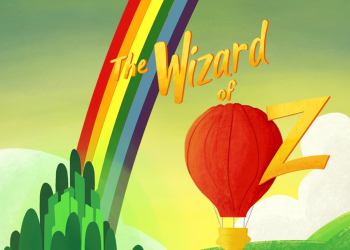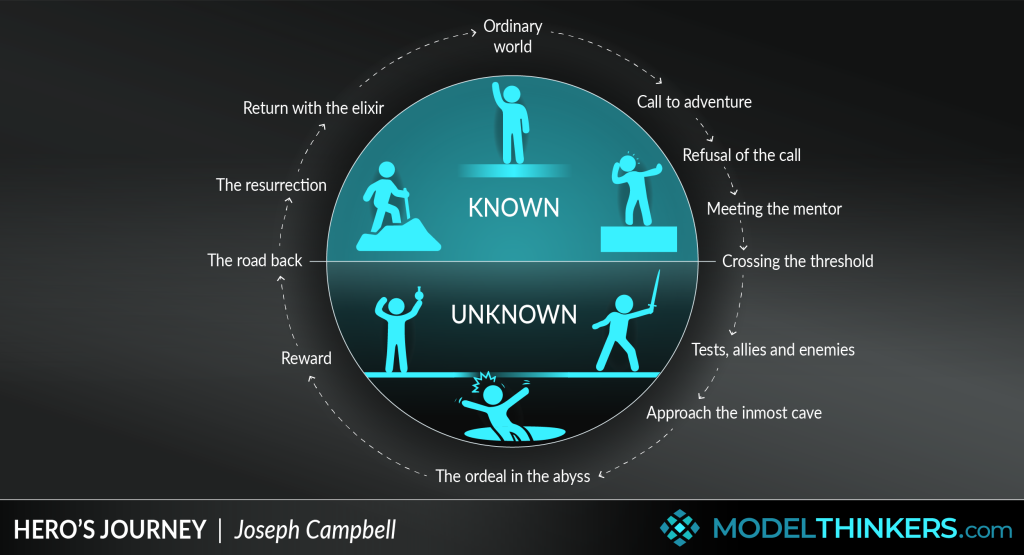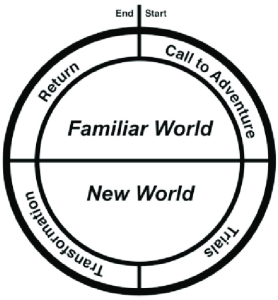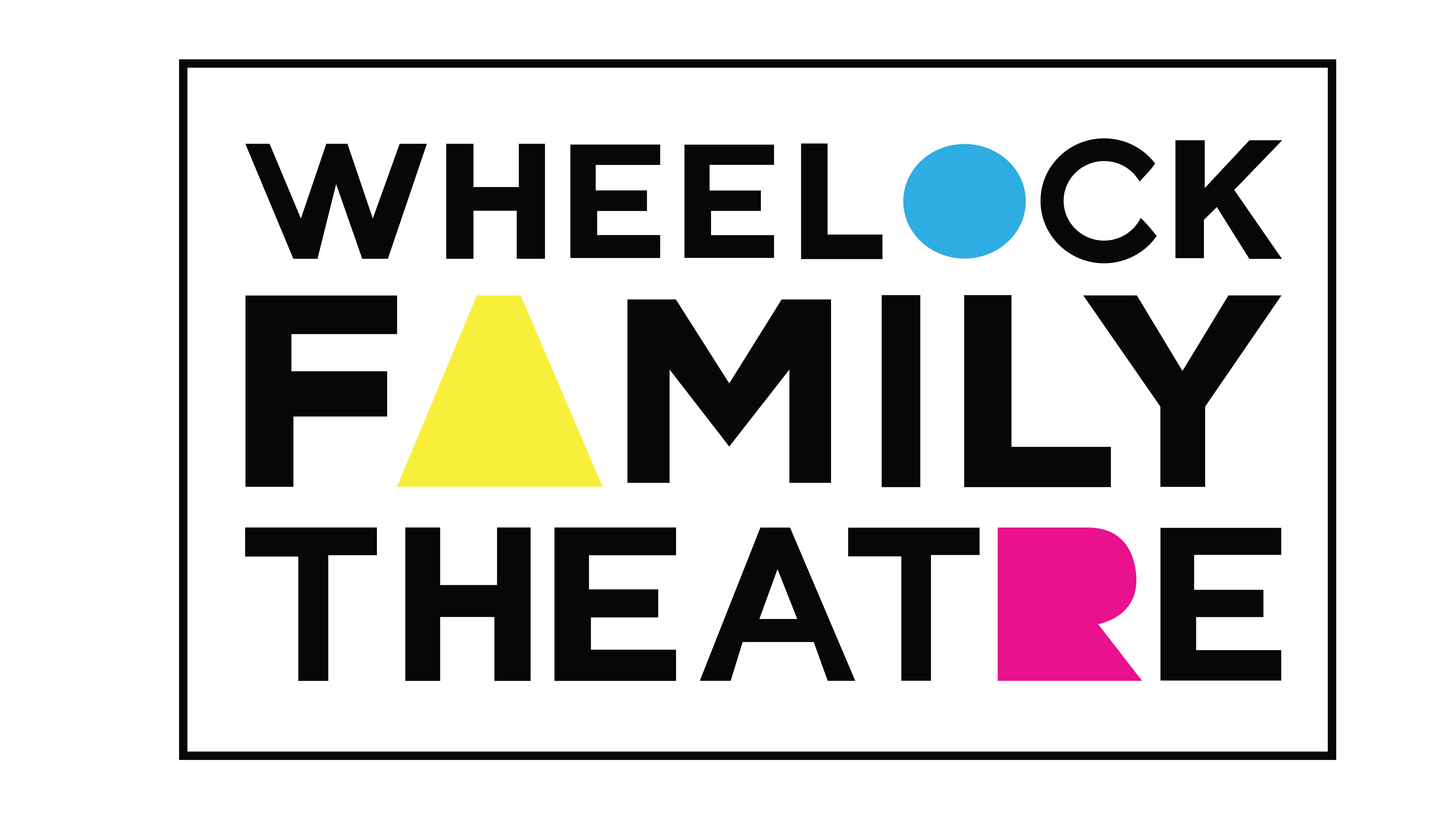LION – Self-Discovery

The Cowardly Lion is the third companion to join Dorothy, rounding out the classic quartet who seek what they think they lack from the great and powerful Wizard of Oz. While lions are famously known as being ‘king of the forest,’ this Lion is so easily frightened that even his own tail scares him! Lion wants ‘the nerve,’ or courage, to face his fears and live bravely in the world. Ultimately, the Wizard gives Lion a medal of honor for displaying courage, but the true testament to the development of his courage is how he overcame fear after fear to make it to the Emerald City at all. This section explores self-discovery through applying and performing the well-known structure of the hero’s journey, analyzing the journeys of the characters, and personalizing the experiences and discoveries of Dorothy, Scarecrow, Tinman, and Lion.
ACTIVITY 1: Applying & Performing the Hero’s Journey
The Hero’s Journey is a well-known story structure that follows a protagonist along a journey through a call to action, allies and obstacles, a significant challenge, and growth as a character. The Hero’s Journey takes place as a series of steps that chart the protagonist’s experience. Below are two representations of the Hero’s Journey – there are many out there, so feel free to find one that works best for you and your students, or make your own!

source: https://modelthinkers.com/mental-model/heros-journey

Source: https://www.researchgate.net/figure/The-Heros-Journey-story-model-The-protagonist-or-hero-starts-in-a-familiar-context_fig2_326720118
Introduce the Hero’s Journey to your class, working together to define each section.
- The Hero’s Journey is often represented as a circle. Why do you think that is?
- Discuss whether The Wizard of Oz fits within the structure of the Hero’s Journey. In what ways do we see Dorothy as a hero? What does Dorothy return to Kansas with that she did not have before – that is, how is she ‘resurrected’ and what is ‘the elixir’ in her story?
- Either individually, in pairs/small groups, or as a whole group, apply the Hero’s Journey to the story of Dorothy in Oz. Which events from the musical correspond to the different sections of the Hero’s Journey?
- Could you apply the Hero’s Journey to characters from The Wizard of Oz other than Dorothy?
- Assign small groups of students a specific part of Dorothy’s Hero’s Journey to act out using movement and dialogue. Perform the sections of the story in order, stopping along the way to discuss and analyze how each scene connects to the Hero’s Journey and how the actors showed that element of the Hero’s Journey structure with their choices onstage.
- Ask students to think of a time when they have undertaken a Hero’s Journey. Students can either list the elements of their story on a Hero’s Journey structure like the ones above, write their story out in full, or act them out with peers.
ACTIVITY 2: Analyzing Journeys & Discoveries
Use any or all of the following questions to initiate discussion on the journeys and discoveries of the characters in Oz. Two thinking routines are provided below the questions to help structure your discussion, should you choose to use them:
- Where would you tell Dorothy’s friends to look for what they want?
- Does the Wizard really have what they want?
- Is it possible to have what you want/need and just not realize it? Explain your answer.
- Do you ever want to be somebody else, or feel mad at yourself, because you can’t do something someone else can? Explain your answer.
- Do you feel more like the Cowardly Lion, the Tinman, the Scarecrow, or Dorothy?
- Did the Tinman act like he had a heart before the Wizard “gave” him one? Did the Cowardly Lion behave courageously before the Wizard gave him the medal? Did the Scarecrow ever have any good ideas before the Wizard gave him his diploma?
- What do you think these three characters share that affects how they see themselves?
- How can self-confidence be like a magic wand?
- How could you “be a wizard” and help a friend who felt bad about themself or was having a hard time?
- If you feel bad about yourself in some way or face a challenge, how can you be your own “wizard”?
Thinking Routine #1: Barometer (adapted from Facing History and Ourselves) – For questions that can be posed as yes/no or multiple choice, ask students to move around the room to different places to show their answer. For example, for the question ‘Does the Wizard really have what they want?,’ designate one side of the room as ‘Yes’ and the other side of the room as ‘No,’ so that students can line up across the room according to how they would answer the question. For the question ‘Do you feel more like the Cowardly Lion, the Tinman, the Scarecrow, or Dorothy?,’ designate one corner of the classroom for each answer. Once students arrive at their positions, ask students in different spaces in the room to explain their answer and why they chose to stand in that place.
Thinking Routine #2: Idea Carousel (adapted from ALL-ED) – Write four different open-ended questions, such as ‘How can self-confidence be like a magic wand?,’ on four different pieces of chart paper, and post one question on each wall of the classroom. This exercise takes place in four rounds:
- Ask students to stand near a question that interests them, or assign them a starting place. Give one student in each group a marker in order to be the scribe for the group. Students have a designated amount of time to respond to the question by discussing and having their scribe write on the chart paper.
- Students rotate to the next question around the room. At this second station, students should read what is written on the paper, then have the scribe write check-marks next to ideas that resonate with the group and add new ideas to the paper.
- Students rotate to the next question around the room. At this third station, students should read what is written on the paper, then have the scribe write check-marks next to ideas that resonate with the group, add new ideas to the paper, and put stars by three ideas or questions they would like to discuss further with the whole class.
- Students rotate to the final question around the room. At this fourth station, students should read what is written on the paper, then have the scribe write check-marks next to ideas that resonate with the group, add new ideas to the paper, and circle an idea they consider to be especially interesting or important.
After visiting all four papers, students return to the original paper where they started. Give students time to take in their peers’ responses and additions to their initial work. They can add exclamation marks next to surprising or exciting new ideas.
Return to the whole group and give students a chance to debrief by sharing what they noticed as they stopped at each question, including ideas that pushed their own thinking in new directions. Ask students to identify questions and topics for further discussion, and pursue those avenues as a class.
ACTIVITY 3: Personalizing the Oz Journey
Provide each student with a piece of paper and ask them to fold it into three sections. Pose each of the following questions one at a time, giving students time to think and write in between:
- On the first third of your paper: If you were in Oz, what would you choose to ask the Wizard for? Why are you asking for this? Why would it be important to you to have this?
- On the second third of your paper: Think about ways in which you might already display this quality. How do you already embody that quality which you think you lack?
- On the third third of your paper: Think about ways in which you might work to develop this quality further. What could you do to focus on your growth in this area?
Extend this exercise by…
- Challenging students to think about the three sections of their paper as a map to achieving a goal. Provide colored pencils so that students can add to their page by illustrating the journey they imagine for themselves: seeking this quality, discovering its presence within themselves, and working to develop it further. Students are encouraged to think symbolically about representing allies and obstacles along their journey using images or signs that might show up on a road-map or treasure map. They can even make a key or legend to pair with their personal map!
- Turning what the students have written into short, improvised scenes. The teacher, or a selected student, goes into role as the Wizard of Oz, sitting on a stool or chair of some prominence in the classroom. One at a time, students go up to the Wizard and explain what they have written on the first third of their paper – that is, what they are asking for from the Wizard and why they want it. The Wizard should improvise with a response or question that challenges the student to articulate what they have written on the second half of their paper – that is, ways they might already display the quality that they profess to want. Finally the Wizard should push the student to describe for themselves the ways in which they could achieve what they want without the Wizard’s help. In this way, the Wizard facilitates the student sharing what they have written in a conversational, safe, improvised yet predictably sequential way.
Contact Us
If you have any questions or would like to share how you and your class engaged with the VLG, send us an email at WFTEd@bu.edu.

